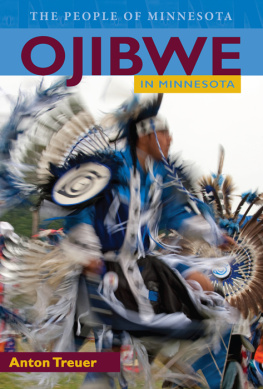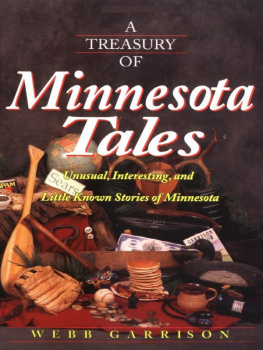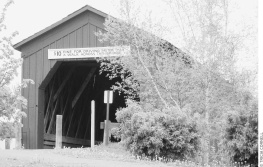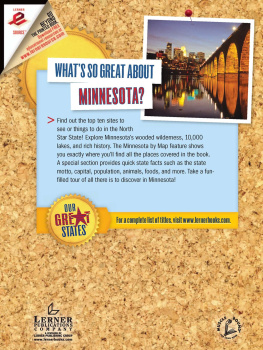Lass - Minnesota: a history
Here you can read online Lass - Minnesota: a history full text of the book (entire story) in english for free. Download pdf and epub, get meaning, cover and reviews about this ebook. City: Minnesota, year: 1998, publisher: W. W. Norton & Company, genre: Art. Description of the work, (preface) as well as reviews are available. Best literature library LitArk.com created for fans of good reading and offers a wide selection of genres:
Romance novel
Science fiction
Adventure
Detective
Science
History
Home and family
Prose
Art
Politics
Computer
Non-fiction
Religion
Business
Children
Humor
Choose a favorite category and find really read worthwhile books. Enjoy immersion in the world of imagination, feel the emotions of the characters or learn something new for yourself, make an fascinating discovery.
Minnesota: a history: summary, description and annotation
We offer to read an annotation, description, summary or preface (depends on what the author of the book "Minnesota: a history" wrote himself). If you haven't found the necessary information about the book — write in the comments, we will try to find it.
Minnesota: a history — read online for free the complete book (whole text) full work
Below is the text of the book, divided by pages. System saving the place of the last page read, allows you to conveniently read the book "Minnesota: a history" online for free, without having to search again every time where you left off. Put a bookmark, and you can go to the page where you finished reading at any time.
Font size:
Interval:
Bookmark:
A
HISTORY
SECOND EDITION
Copyright 1998 by William E Lass Copyright 1977 by
American Association of State and Local History
First published as a Norton paperback 2000
All rights reserved
For information about permission to reproduce selections from this book, write to Permission
W W Norton & Company, Inc, 500 Fifth Avenue, New York, NY 10110
The text of this book is composed in Garamond No 3
with the display set in Poster Bodoni Compressed
Desktop composition by Platinum Manuscript Services
Manufacturing by The Courier Companies, Inc
Book Design by JAM Design
Library of Congress Cataloging-in Publication Data
Lass, William E
Minnesota a history / William E Lass2nd ed
pcm
Includes bibliographical references and index
1 MinnesotaHistory I Title
F606L351998
977 6dc21 97-34650
CIP
ISBN 978-0-393-34854-5 (e-book)
W. W. Norton & Company, Inc.
500 Fifth Avenue, New York, N.Y. 10110
www.wwnorton.com
W. W. Norton & Company Ltd.
Castle House, 75/76 Wells Street, London WIT 3QT
To the memory
of my wife,
Marilyn J, Lass
(1932-94)
Maps
T HE EARLIER VERSION of this book, titled Minnesota: A Bicentennial History, was published in 1977 as part of the States and the Nation series. Like it, this volume is not intended to be a comprehensive history, but rather a survey that emphasizes the historical interplay of Minnesotans and their ever-changing environment. During the score of years that has elapsed since the book first appeared, I have continued teaching, researching, and writing the history of my adopted state. Like all historians engaged in the everlasting quest to have the last word, I have strived to keep apace of the elusive present.
Much has happened in Minnesota and elsewhere in the last twenty years. As the cumulative effects of events have evolved into trends, perspectives about the past have been adjusted. Some aspects of Minnesotas development, such as concern for environmental protection and accelerating metropolitanism, have demonstrated strong continuity. But others have featured changes far greater than those generally anticipated in the bicentennial year. Certainly, the conservative resurgence has altered the way Minnesotans collectively look at their relationship with government.
In preparing this edition I have both revised and expanded the original book. Certain aspects have been changed to reflect todays perspective, scholarship, and word usage. The coverage of the last two decades concentrates on recent economic and political developments.
The writing of this history has been greatly facilitated by the extensive collections of the Minnesota Historical Society and the holdings of the Marilyn J. Lass Center for Minnesota Studies at Mankato State University. I am particularly grateful to Robert (Skip) Drake, site manager of the Minnesota Historical Societys Forest History Center at Grand Rapids, and Deborah L. Miller, research supervisor of the Minnesota Historical Society. Both read and critiqued portions of the manuscript and assisted in other ways. Jean A. Brookins, the Minnesota Historical Societys assistant director for publications and research, and Anne R. Kaplan, editor of Minnesota History, kindly suggested sources of information. Dana H. Miller of the Mineland Division of the Iron Range Resources and Rehabilitation Board cordially answered many of my questions about the iron industry and arranged tours of two taconite plants for me.
In obtaining information on Minnesotas forest industries I benefited from the assistance of a number of individuals. John Krantz and Bruce Zumbahlen of the Forestry Division of the Minnesota Department of Natural Resources graciously responded to my inquiries. Jack LaVoy, executive vice president of both the Minnesota Forest Industries and the Minnesota Timber Producers Association, gave me invaluable insights into present-day forestry. Bob Behr, area forestry coordinator of the Forestry Division of Blandin Paper Company, introduced me to the current forest harvesting technology and helped explain a number of the technical aspects of forestry. Ronald A. Herbig, the supervisor of employee relations, and Alan Barse, both of the Potlatch Corporation Oriented Strand Board Plant in Grand Rapids, were genial hosts during my plant tour. John Chell, manager of public relations for the Blandin Paper Company, provided information on the forest industry, and Jack I. Rajala and John Rajala of the Rajala Companies at Deer River enthusiastically explained recent changes in wood-products production and marketing.
I gained a better understanding of recent developments in the taconite industry by visiting with Wayne E. Brandt, the president of the Iron Mining Association of Minnesota. The highlight of my taconite research was a personal tour conducted by John Rowe of the National Steel Pellet Companys mine and plant at Keewatin. I benefited immensely from his extensive knowledge about the transition of Minnesotas iron industry during his thirty-five years of experience with it.
Several of my Mankato State University colleagues assisted in various ways. Bruce L. Larson, professor of history, facilitated my understanding of Scandinavian aspects of Minnesotas history. Peter Jarnstrom, the interlibrary loan librarian, was enthusiastic and prompt in processing my requests, and Alan O. Wiese, professor of political science, shared his research on Minnesota gambling with me. In readying the manuscript I received invaluable assistance from Yvonne Schmeling, administrative secretary of the College of Graduate Studies, whose typing and computer skills are greatly appreciated.
I also appreciate the assistance and interest of James L. Mairs, vice president of W. W. Norton. He edited the manuscript, helped in locating and selecting illustrations, and cordially directed all stages of the books production. Nearly all of the illustrations were obtained from the splendid photographic collection of the Minnesota Historical Society. Obtaining them was greatly facilitated by the enthusiastic cooperation of various Minnesota Historical Society personnel. In particular I thank Bonnie G. Wilson, Curator of Sound and Visual Collections, Ann Christensen and Angie Noyes of the copy center, and Bridgit White of the photo lab.
Lastly, I thank my children, Barbara and Bill, for their continued encouragement and support.
WILLIAM E. LASS
Mankato, Minnesota
November 1996
A
HISTORY
SECOND EDITION
D URING THE SPRING of 1965, Minnesota reeled under a succession of blizzards, floods, and tornadoes. Through it all the state legislature debated daylight saving time with great fervor. Residents took it all in stride, quipping that Minnesotans were people with snow in their yards and water in the basements of their roofless houses who did not know what time it was. The experience reminded them of natures impact throughout the states history.
Minnesotans have always been close to nature. The geographic forces that influenced the past are still very much a part of their lives, for geography is active and evolving. Minnesotans have been shaped by the land, and they in turn have shaped it. Through this interaction the people and the institutions of todays Minnesota have emerged.
Minnesotas bountiful waters have molded the states character just as surely as the search for scarce water has influenced much of the Great Plains and the American Southwest. Because Minnesotas waters contribute to three distinct drainage basins, the state is sometimes called the Mother of Three Seas. Most of the states land is drained by the Mississippi and its tributaries, which flow to the Gulf of Mexico; but the land that lies to the north and west is drained northward to Hudson Bay, while the area about Lake Superior lies in the Gulf of St. Lawrence drainage. If Minnesota had been landlocked, her history would be far different: the water connections were the paths to the interior for French and British explorers and for the American frontiersmen, and they are plied yet today by modern vessels.
Font size:
Interval:
Bookmark:
Similar books «Minnesota: a history»
Look at similar books to Minnesota: a history. We have selected literature similar in name and meaning in the hope of providing readers with more options to find new, interesting, not yet read works.
Discussion, reviews of the book Minnesota: a history and just readers' own opinions. Leave your comments, write what you think about the work, its meaning or the main characters. Specify what exactly you liked and what you didn't like, and why you think so.









